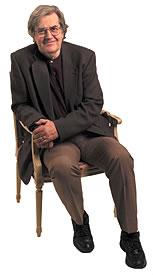A few years ago, I was on an airliner about to make a landing in Denver. As any experienced flyer knows, a landing at this airport is always subject to the turbulence of air coming in over the mountains. But on this day, the turbulence was extraordinary; some of the worst I have experienced as a passenger. So troublesome was it that the pilot aborted his first landing try and went around for a second effort.
A woman sitting next to me was rather perturbed by the experience, and asked me "do you think we’ll ever get on the ground?" "I guarantee it," I responded. "I know enough about physics to be able to assure you that we will not be floating around up here forever. The forces of gravity will see to it that we will end up on the ground. What shape we will be in is another matter!" She laughed and, bumpiness and all, the pilot made a safe landing.
This event reminded me of an oft-ignored truth: pilots do not land airplanes; gravity lands airplanes. A skilled pilot has learned how to maneuver and manipulate many thousand pounds of metal in order to trick gravity into reducing the harshness of its mandate that objects fall at an accelerating rate of 9.8 meters per second squared. The pilot is not simply a machine responding in some programmed manner, but is engaged in a kind of performance art. As with any artist, a competent pilot is able to combine his or her learned, mechanical skills with judgments gained from years of experience in playing with gravity’s seemingly inexorable rules.
155 passengers and 5 crew members of a U.S. Airways flight were fortunate to have been in a plane under the control of a highly skilled pilot, Chesley Sullenberger III. His now-famous landing of a powerless jet on the Hudson River provides more than simply evidence of his mechanistic skills — as great as those were — but of his judgment in deciding for a watery landing. A less experienced — though equally skilled — pilot might have opted for the suggestion made to him of trying to nurse what had now become a glider to a nearby airport. Had that decision been made, we might now be reading of more than 160 fatalities following the plane crashing into a row of apartment buildings. Capt. Sullenberger was a performance artist — a man who is also a glider instructor — who, carrying out a judgment that in this instance only he was capable of making in response to the peculiar circumstances which he faced, completed his dance with gravity’s indifference to outcome, albeit in an unexpected venue.
Upon landing in the river, and with the fate of 160 people in the balance, rescue efforts immediately began. Officials of the FAA, Homeland Security Secretary Michael Chertoff, New York Mayor Bloomberg, and Senator Hillary Clinton, all descended on the scene to begin helping passengers to safety. No? It didn’t work out that way? But it must have been so. Is it not an integral part of our thinking that social order can be fostered and sustained only by a political system that can plan for responses to troublesome events? Wasn’t this the logic upon which federal, state and city governments acted in New Orleans, following hurricane Katrina? Do we not elect politicians who, in turn, create bureaucracies to make our lives secure?
Initially, the only seen presence of government at the site of the U.S. Airways emergency landing involved police helicopters interfering with rescue efforts by keeping the water around the plane churned up. These helicopters were of value to the state, of course, as a visual symbol of its superintending presence above a scene in which its practical role was nonexistent. Like a president or state governor flying over an area hit by a tornado or flooding, such an aerial presence reinforces the vertically-structured mindset upon which political authority depends. After rescue efforts were substantially completed — with no loss of life — New York and New Jersey police officials arrived (those whom the New Jersey governor incorrectly described as the "first responders").
The real work of rescuing passengers and crew members was left to the sources from which the only genuine social order arises: the spontaneous responses of individuals who began their day with no expectation of participating in the events that will henceforth be high-water marks in their lives. After the airliner came to a stop, one private ferry-boat operator, sensing the danger of the plane’s tail submerging, began pushing up on the tail in an effort to keep it elevated. Other private ferry-boat operators — whose ordinary work involved transporting people between New York and New Jersey — came to the scene in what became a spontaneously organized rescue under the direction of no one in particular. Photos of the area show the plane surrounded by ferryboats on all sides.
On board the plane, passengers were making their own responses. CNN’s Wolf Blitzer — a man who has probably seen one-too-many Irwin Allen films — interviewed a passenger, asking whether those aboard the plane were yelling and screaming at their plight. "No," the man replied, going on to describe how calm and rational was the behavior of his fellow passengers; removing exit doors; putting on life vests; and helping one another get out onto the wing of the plane.
This man’s words reminded me of so many other descriptions I have heard from those who find themselves involved in catastrophes. A few weeks after 9/11, I spoke with a man and a woman who had been in one of the World Trade Center buildings on that day. I asked them how those leaving the damaged building behaved. Each replied that people were calm but determined as they left the building; they saw no screaming or yelling persons running frantically from the building. In my book, Calculated Chaos, I have provided a description of the informal, spontaneous responses of many Omahans to the damage inflicted by a tornado upon that city in 1975.
One of the more telling distinctions between informal and formal responses to problems was seen in Capt. Sullenberger’s being the last person to leave the plane but, before exiting, making two trips through the aircraft to be certain that everyone on board, for whom he felt responsible, had gotten off. No government officials would likely have deigned to exhibit such a personal sense of responsibility: they would have been too busy conducting press conferences!
Whether we are considering the patterns of regularity found in the marketplace, or from our relationships with strangers on streets and highways, or, in this case, the aftermath of a disaster or near-disaster, so much of the order that prevails within society arises, without anyone’s intention, as a result of our pursuing other ends. Our politicized training — reinforced by media and government officials — leads most of us to believe that social order is the product of the conscious design of wise leaders, whom the political process allows us to identify and elect. In the face of the wars and economic collapse that are now destroying our world, it is difficult for intelligent men and women to any longer embrace such childlike thinking that is probably a carryover from a dependence on parental authority.
As the events of that day slowly fade, those most immediately affected will recite, for others, their recollections. Capt. Sullenberger will doubtless enjoy his well-deserved hero status with appearances on television and radio programs. The ferryboat operators will likewise enjoy their earned fifteen minutes of fame. Other than memories, nothing permanent will come of this event. Those directly involved will return to their normal work: Capt. Sullenberger piloting other flights; ferryboat operators transporting people across the Hudson.
 But the statists will figure out ways to exploit all of this for their narrow ends, insinuating their non-existent roles in the rescue. In an effort to reinforce the illusion that their authority carried the day, the politicians — along with Homeland Security officials — will likely concoct statutes or other rules in an effort to repeat, in the future, the kinds of spontaneous responses that arose, without design. Hearings will probably be conducted on behalf of some proposed "Water-ditching of Aircraft" regulations — to be administered by a newly-created federal agency to be housed in the Department of Homeland Security. Thereafter — and reflecting the governmental responses in New Orleans — woe be unto any future Capt. Sullenberger who dares to exercise his independent judgment should it conflict with government-mandated conduct. Nor shall this agency be inclined to tolerate the unapproved efforts of ferryboat operators — or others — who might dare to act, without prior authorization to save lives.
But the statists will figure out ways to exploit all of this for their narrow ends, insinuating their non-existent roles in the rescue. In an effort to reinforce the illusion that their authority carried the day, the politicians — along with Homeland Security officials — will likely concoct statutes or other rules in an effort to repeat, in the future, the kinds of spontaneous responses that arose, without design. Hearings will probably be conducted on behalf of some proposed "Water-ditching of Aircraft" regulations — to be administered by a newly-created federal agency to be housed in the Department of Homeland Security. Thereafter — and reflecting the governmental responses in New Orleans — woe be unto any future Capt. Sullenberger who dares to exercise his independent judgment should it conflict with government-mandated conduct. Nor shall this agency be inclined to tolerate the unapproved efforts of ferryboat operators — or others — who might dare to act, without prior authorization to save lives.
 I will be surprised if the bureaucratic control freaks fail to see this event as an opportunity to expand their forced ministrations upon human affairs. The National Transportation Safety Board will make its routine "investigation" — to reinforce the supervisory mindset that, in finding out "what went wrong," the government will be able to "keep this from happening again." What will be overlooked in all of this is the fact that volumes upon volumes of FAA regulations already micro-manage air travel, and that such directives played no part in this emergency landing.
I will be surprised if the bureaucratic control freaks fail to see this event as an opportunity to expand their forced ministrations upon human affairs. The National Transportation Safety Board will make its routine "investigation" — to reinforce the supervisory mindset that, in finding out "what went wrong," the government will be able to "keep this from happening again." What will be overlooked in all of this is the fact that volumes upon volumes of FAA regulations already micro-manage air travel, and that such directives played no part in this emergency landing.
Those who believe themselves capable of directing complex systems for the achievement of desired ends, are unaware of the fact that the separate — but interconnected — events in our lives are underlain by numerous influences peculiar to given situations. The forces that combined to create the situation to which Capt. Sullenberger made his spontaneous response, will likely never recur. On the other hand, there will be another pilot who, on some future day, will have to deal with unforeseen and even bizarre circumstances to which he — like the good captain in this case — will have to be flexible enough to respond.
But as the politically-minded seek to exploit this near-tragedy into some "what if" hypotheticals to rationalize their ongoing quest for power over others, 155 passengers, 5 crew members, and their families, can celebrate the fact that they owe their lives not to government planning, but to the playing out of a spontaneous order for which no planning was possible.





